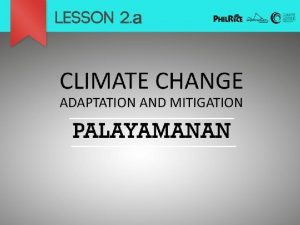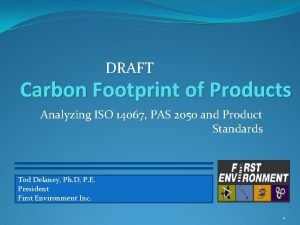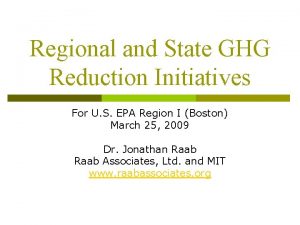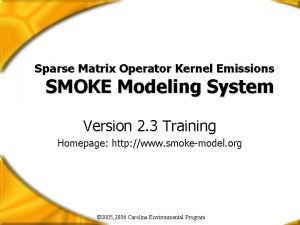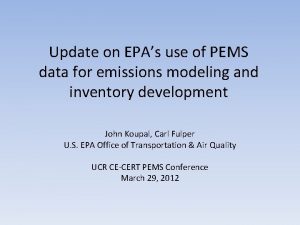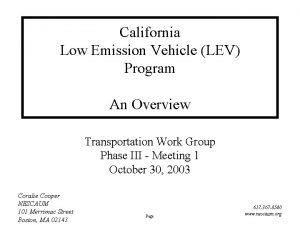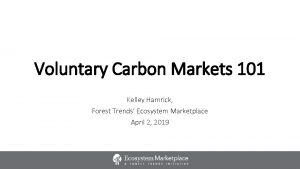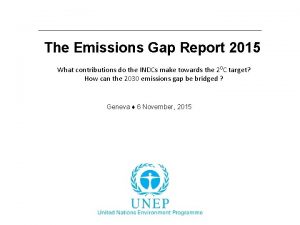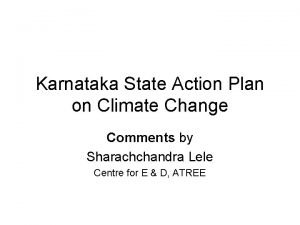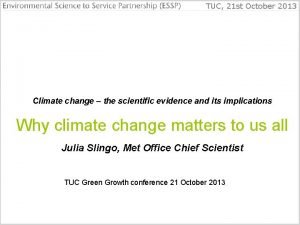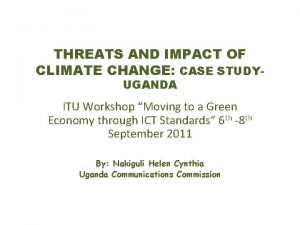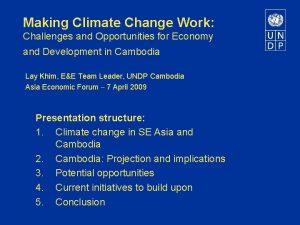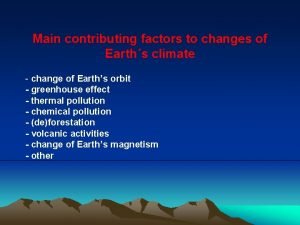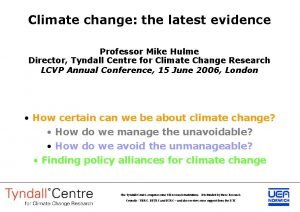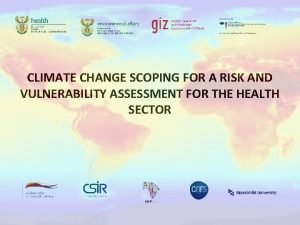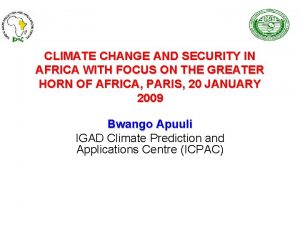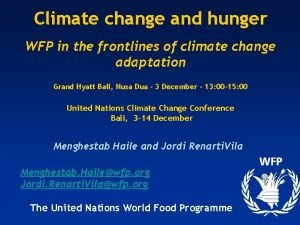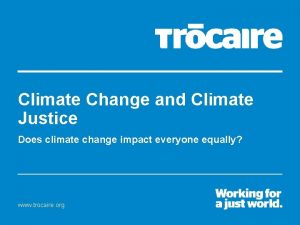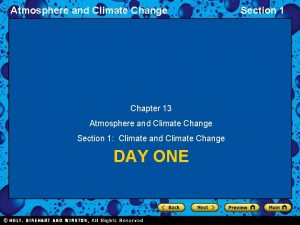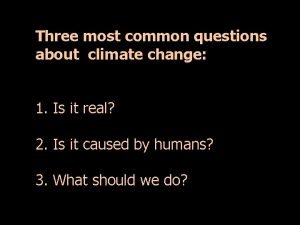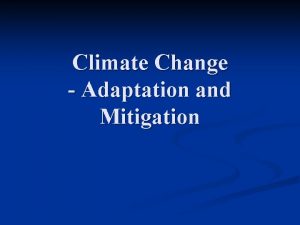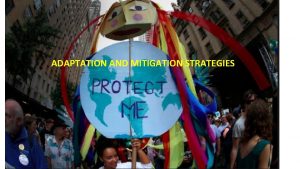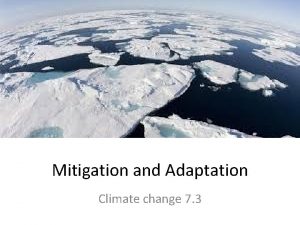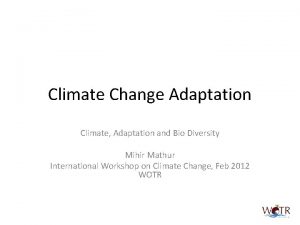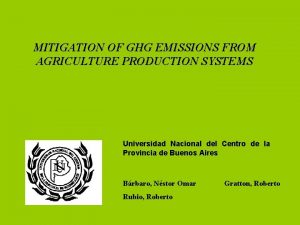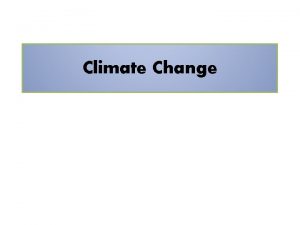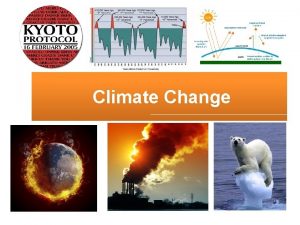Climate Change Planning Process Mitigation Adaptation GHG Emissions


















































- Slides: 50

Climate Change Planning Process Mitigation Adaptation GHG Emissions Assessment Vulnerability Assessment Setting targets Setting objectives Assessment and selection of measures Implementation of measures Monitoring and Evaluation of Measures

Mitigation Adaptation GHG Emissions Assessment Vulnerability Assessment Key Questions Which sectors are the How is your city exposed to largest emitters of GHGs? climate change today and in the future? How sensitive are your city’s people, places and institutions to this exposure? Who is most vulnerable and least able to adapt? What sectors / assets / groups are most important? Source: UN Habitat

Mitigation Adaptation GHG Emissions Assessment Vulnerability Assessment Setting targets Setting objectives Key Questions How much GHG emissions Would the objective be to reduction would you increase adaptive capacity – or reduce sensitivity or target? exposure? Is this target for the city What other broader or municipality level or development objectives for a specific sector? (e. g. poverty, education) can you address along with climate change adaptation?

Mitigation Adaptation GHG Emissions Assessment Vulnerability Assessment Setting targets Setting objectives Assessment and Selection of Measures Key Questions Which measures (actions, policies, initiatives) can you identify to achieve the set targets or objectives? After identifying the actions, how do you select which ones to implement first, which is a process called prioritization?

DECISION MAKING IN PLANNING FOR CLIMATE CHANGE Using CLIMACT PRIO: A decision support tool for climate change adaptation and mitigation prioritization

CLIMACT Prio tool how to prioritize climate change adaptation and mitigation actions A system to guide policy makers’ and planners’ decisions in planning for climate change

Relevance & Application of CLIMACT PRIO TOOL Planning for Climate Change (UN Habitat, 2014) City Development Strategy Toolkit (Cities Alliance, 2016) Toolbox of Methodologies Climate and Energy http: //toolbox. climateprotection. eu/home/ Participatory integrated assessment of flood protection measures for climate adaptation in Dhaka (Haque et al. , 2012)

Relevance: Participatory planning Participatory integrated assessment of flood protection measures for climate adaptation in Dhaka (Haque et al. , 2012) Urban Planning and Design Labs: tools for integrated and participatory urban planning (UN Habitat, 2016)

CLIMACT Prio tool CLIMACT PRIO is a climate awareness, decision support, and capacity building tool for screening and prioritizing climate change actions. By prioritizing, this refers to bringing down the climate change actions “from wish list…to a feasible and relevant short list”. Watch the CLIMACT PRIO TOOL video.

What is the workshop about? At the end of this week, each group, whose members will simulate the role of multiple stakeholders, can identify, assess, prioritize, and present 6 local climate change adaptation and mitigation actions to reduce vulnerability and emissions based on the selected case study

CLIMACT PRIO TOOL: STEPS Step 0: Identifying the most vulnerable sectors (and local problems) Step 5: Scoring and standardization of actions Step 6: Weighting of criteria Step 1: Listing, screening, and ranking of adaptation actions Step 4: Identification of evaluation criteria Step 7: Results of weighted scores and final ranking Step 2: Selection of adaptation actions Step 3: Marginal Abatement Cost (SKIP) Step 8: Prioritization of actions

Step 0 – Read the city’s vulnerability profile

Disaster Management Agriculture Infrastructure Water Management Flood Management Health Ecology Transport Social • Identify sectors/assets with highest priority for action • Look at other possible issues or problems that the city is facing

CLIMACT PRIO TOOL: STEPS Step 0: Identifying the most vulnerable sectors (and local problems) Step 5: Scoring and standardization of actions Step 6: Weighting of criteria Step 1: Listing, screening, and ranking of adaptation actions Step 4: Identification of evaluation criteria Step 7: Results of weighted scores and final ranking Step 2: Selection of adaptation actions Step 3: Marginal Abatement Cost (SKIP) Step 8: Prioritization of actions

Disaster Management Agriculture Infrastructure Water Management Flood Management Health Ecology Transport Social • Identify sectors/assets with highest priority for action • Look at other possible issues or problems that the city is facing

Step 1 a – Listing of 10 possible adaptation actions


Step 1 b – Screening and ranking of alternative adaptation actions

• Study the feasibility and impact criteria – and their corresponding descriptions and scoring scale.

• Evaluate each alternative adaptation action against each of the seven feasibility and impact criteria.

Step 1 b – Feasibility ranking of adaptation actions • Observe how all the scores for each adaptation action add up as well as the over all ranking and the results of the feasibility index. Total: sum of feasibility and impact criteria scores Ranking: ranking of final scores Feasibility Index: average sum of all feasibility scores

• Observe the feasibility graph. Also, examine the ranking of all adaptation actions as well check all adaptation and individual actions based on the Feasibility Index and the Total Score.

Step 2 – Selection of 6 adaptation actions

Step 3 – Identification of 5 evaluation criteria from different categories Environmental Economic Social Climate Feasibility Governance The criteria selected can be of a diverse nature and should relate to broader local governments’ priorities and objectives

Evaluation Criteria need to be SMART: Specific, sensitive, solid Measurable Relevant, reliable, realistic Achievable, applicable, acceptable Time bound

The criteria selected can be of a diverse nature and should relate to broader local governments’ priorities and objectives. Define a unit of measurement for each criterion (“ 1 -5”) and specify the direction of preference (Min/Max).

Step 4 – Scoring of actions (Impact Assessment Matrix) • Assign scores for each adaptation action against the selected evaluation criteria. • Learn more about their advantages, disadvantages, costs and benefits, and financing options. • Use the template for climate actions provided.

Scoring – Standardized scores • One must standardize the values in order to be able to compare the scores. • This is done automatically for CLIMACT PRIO. • The higher the numbers represent a positive outcome and lower numbers represent less positive or negative outcomes.

Standardization Graphs

Standardization Graphs

Comparison Average vs. Rainwater harvesting Vulnerability reduction 1. 0 0. 5 Biodiversity preservation Employment generation 0. 0 Public acceptance Livelihood security

Step 5 – Weighting of criteria by stakeholders

Impact range: the maximum score minus the minimum score assigned to each action in the impact matric

Degree of Weights: the average Convergence: of all scores for all indicates the degree of stakeholders consensus on different criteria • Observe the final criteria weighting. • Observe if there is low degree of convergence.

• Which criteria are most valued?

Results of Weighted Scores Final weighted scores: weighted summation between the standardized scores of the impact matrix and the weights assigned to each criterion

Results – Ranking

Step 6 – Prioritization of Actions • • • How can the final ranking be explained? Which criteria contribute mostly to the highest ranked alternatives? Which criteria (objectives) will be met by the actions?

Prioritization of Actions Water storage and conservation Rainwater harvesting Design standards Construction of evacuation centers Emergency medical services Early warning systems What does the prioritization of actions imply for the city’s climate adaptation policy?

Developing a Climate Change Action Plan 1. Address both mitigation and adaptation in an integrative manner 2. Designate the spatial location of actions/inteventions 3. Determine the timeframe for the implementation of actions 4. Identify financial resources for the implementation of actions 5. Indicate relevant stakeholders and possible partnerships

What does an Action Plan include? Why How ? When Who What Where

What does an Action Plan include? Main issues (vulnerabilities and emissions based on assessment) Objectives (priorities, targets based on plans) Why Resources (e. g. budget), mainstreaming into existing plans and policies Timeline, , overlap, synergies between Actions How When Where Spatial distribution of Actions on the city’s map Who Stakeholders What Prioritized Climate Change Actions (with Adaptation & Mitigation co-benefits & trade-offs)

What does an Action Plan include? Main issues (vulnerabilities based on assessment) Objectives (priorities, targets based on plans) Why Resources (e. g. budget), mainstreaming into existing plans and policies Source: Vulnerability Assessment, GHG Inventories How Who Method: …Desk study! Timeline, , overlap, synergies between Actions When What Tool: Gantt chart Where Spatial distribution of Actions on the city’s map Stakeholders Tool: Stakeholder mapping Prioritized Climate Change Actions (with Adaptation & Mitigation co-benefits & trade-offs) Tool: Climact Prio Tool: Visualization, mapping software

Stakeholders map Secondary stakeholders Primary stakeholders Key stakeholders Civil society Private sector z or Issue(s) Objectives Public sector

Spatial distribution of actions Source: UMD 10 students

Timeline: gantt chart Source: IHS Action Planning Workbook Note: this is a rough Gantt Chart example, it should not be taken as being ideal or realistic!

Timeline, Stakeholders & Resources Apart from the timeplan, the gantt chart can be used to present additional information for the Actions planned: Actions Action 1 Action 2 Action 3 Etc …. Time division: Days / Weeks / Months / Years Stakeholders Notes on resources & mainstreaming

Workshop schedule

Useful tips for the CLIMACT Prio week • First think, then (Clim)act! Brainstorm as a group using the flipcharts and metaplan cards, at each step of the prioritization process. Fill in the spreadsheet when you have taken your decisions. • One “official” file Each member may want to have their own files to experiment with the tool. However, on Day 1 you should decide as a group who will have the official file that presents your work. This is the file that you will submit at the end of the workshop to be graded. • Appoint roles to the team members Each time should have 1 time manager and 1 “official spreadsheet” user who inserts the data. You may want to add more roles (e. g. visualiser) to organise the team and share the workload.

Useful tips for the CLIMACT Prio tool • Adaptation Actions Brainstorm on both structural and non-structural actions. • Measurement units Use one of these measurement scales: 1 -5 or 1 -10. • Minimizing / maximizing Criteria When identifying your criteria, be careful. If the criterion has a negative connotation, like “cost”, you want to minimize it. If it is something positive, e. g. “employment generation”, you want to maximize it! • Scoring Actions according to Criteria! If you have chosen “maximize”, the highest number (e. g. 5 or 10) represents the most desired score. If you have chosen “minimize”, the lowest number (1) represents the most desired score.
 Climate change 2014 mitigation of climate change
Climate change 2014 mitigation of climate change Climate change mitigation
Climate change mitigation Pakikibagay sa sitwasyon kahulugan
Pakikibagay sa sitwasyon kahulugan Mitigation vs adaptation
Mitigation vs adaptation Iso 14067
Iso 14067 Ghg protocol ict sector guidance
Ghg protocol ict sector guidance Ghg calculator excel
Ghg calculator excel Ghg exercise
Ghg exercise Ghg+
Ghg+ Ghg protocol ict sector guidance
Ghg protocol ict sector guidance U.ghg
U.ghg Ghg protocol revised
Ghg protocol revised Volkswagen scandal ethics
Volkswagen scandal ethics Sparse matrix operator kernel emissions
Sparse matrix operator kernel emissions Diesel emissions denver
Diesel emissions denver Sources of nox emissions
Sources of nox emissions Nocturnal emissions causes
Nocturnal emissions causes Pems emissions modeling
Pems emissions modeling Flame test results table
Flame test results table Lev 2 emissions
Lev 2 emissions State of the voluntary carbon markets 2017
State of the voluntary carbon markets 2017 Un emissions gap report
Un emissions gap report 4 kinematic equations
4 kinematic equations Using citys heat reduce emissions
Using citys heat reduce emissions Acoustic emissions testing
Acoustic emissions testing Ghs emissions
Ghs emissions Particulates can be removed from smokestack emissions by
Particulates can be removed from smokestack emissions by Climate change paragraph
Climate change paragraph Karnataka state action plan on climate change
Karnataka state action plan on climate change Why are tropical climates so hot brainpop
Why are tropical climates so hot brainpop Climate change meaning and definition
Climate change meaning and definition Atmosphere
Atmosphere Unit 9 climate change
Unit 9 climate change Conclusion of climate change
Conclusion of climate change Youreuropemap.com
Youreuropemap.com Conclusion of climate change
Conclusion of climate change Mathematics of climate change
Mathematics of climate change Globalization ap world history definition
Globalization ap world history definition Pc 414
Pc 414 Conclusion of climate change
Conclusion of climate change Factors of climate change
Factors of climate change Human causes of climate change
Human causes of climate change Theoretical framework example
Theoretical framework example Uk climate change
Uk climate change Climate change interview
Climate change interview Factors effecting climate change
Factors effecting climate change Conclusion of climate change
Conclusion of climate change Conclusion of climate change
Conclusion of climate change Climate change causing droughts
Climate change causing droughts Chapter 13 atmosphere and climate change
Chapter 13 atmosphere and climate change How to reduce climate change
How to reduce climate change


